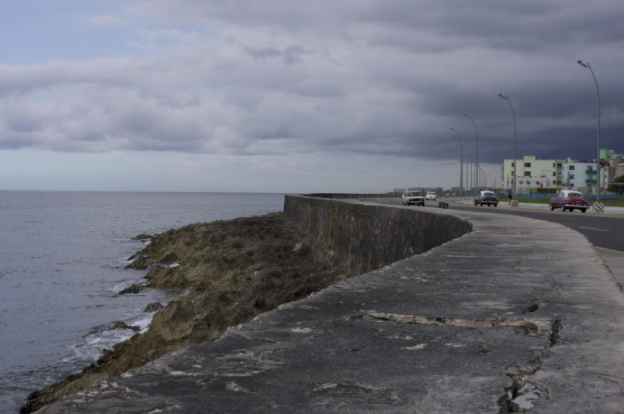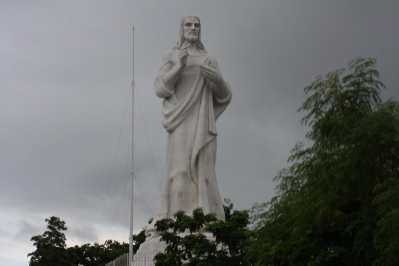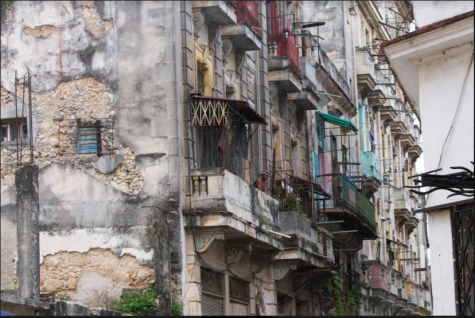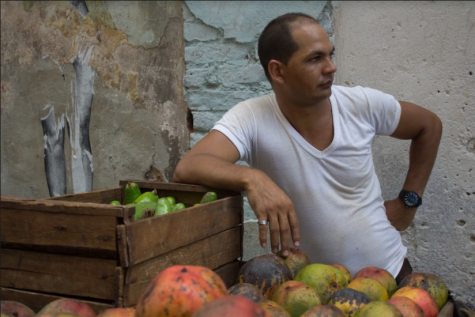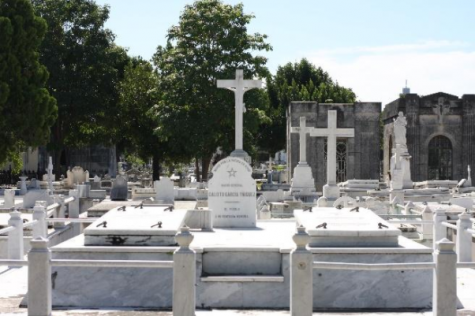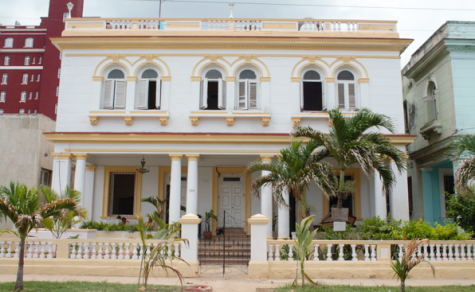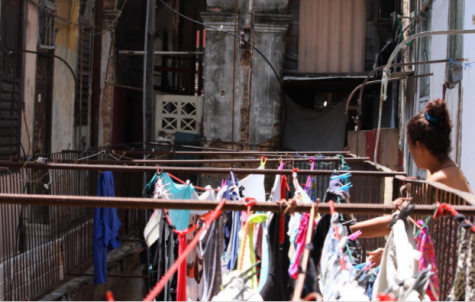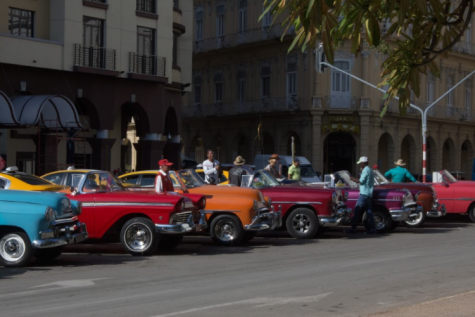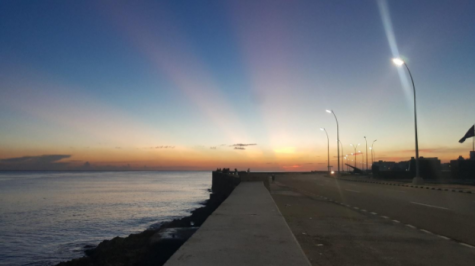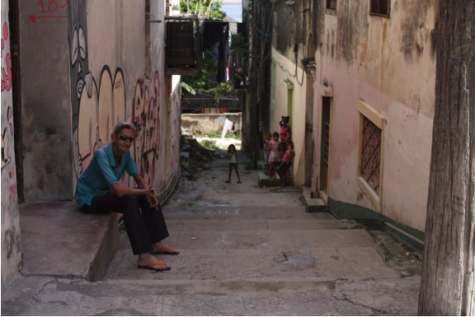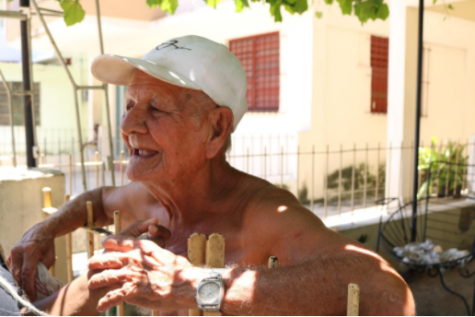Hannah Childress
August 27, 2017
Pride for the Malecón; neglect of the water beyond
For many years the Malecón, which separates the city of Havana, Cuba from the Caribbean Sea, has been frequently used as a social gathering spot for residents of Havana.
In previous years locals would use the water beyond the Malecón as an escape from the heat. Since then, the Cuban government has deemed it off limits, claiming that the pollution in the water is too toxic for humans to swim in.
The Malecón is a seawall that began construction in the 1920s and, due to multiple presidencies with different objectives, it wasn’t until the 1950s that construction on the wall was completed.
As a visitor of Cuba, it is interesting to see how massive the Malecón is and how it completely removes any human interaction from the water as if it is a forbidden land.
When you walk along the wall during the day, it is nearly deserted of people, yet at night, especially on a Saturday evening or holiday, hundreds of local residents swarm the Malecón. Many people will use the wall as a place to sit. Almost every person that I observed sitting on this wall sat facing the city, neglecting the water behind them.
Beyond the wall border the water is vast, and yet it is rare to see boat traffic, unlike most major city coastlines in the world. The complete non-existence of boat launches or harbors in Havana could be to blame for the low boat traffic. On the other hand, the Cuban government’s decision to ban any bathing activities in the Havana waters makes access prohibited. Additionally, the massive Malecón acts as a definitive boundary removing any human interest in taking pride in the Havana coastline and promoting one of the many beauties that define the city of Havana.
The human spirit in a neglected Havana
Some might look at the city of Havana, Cuba and think that the conditions of the neglected buildings would affect the demeanor of the local residents; however, this is far from the truth.
Cuba’s deprived economy has led to the neglect of maintaining the iconic buildings of Havana and over many decades, has left it nearly in disrepair.
As I walk down these residential streets I am intrigued by the character that these old buildings possess. Although they would be considered an eyesore back home in America, I look past the aesthetics and find beauty in the stories and lives that they hold.
On the first impression, a visitor could form an assumption that the dilapidated buildings would break down the human spirit of Havana residents. After spending some time exploring and talking to the locals, I have discovered that the buildings do not mirror the emotions of the locals.
Every encounter I had with a local Cuban was greeted with a smile and curiosity of where I am from and what I think of their country.
Along my walk, I stopped in at a small outdoor fruit and vegetable market called Agromercado, which is managed by a woman named Margarita. Within seconds stepping into the market, Margarita greeted me and although I could only understand half of the things she was saying to me, I could tell that she was just as excited as I was for the cultural exchange between the both of us.
By the end of our exchange, I learned her name, where her sister lives and how to say the different names of the fruits and vegetables she was selling. She also insisted that I take two guavas with the trust that I would bring her money tomorrow for the fruit.
America’s standard of living is completely different and often times based on superficial expectations. As an American visitor in Cuba, it is a humbling experience to see the human spirit thrive in an impoverished region.
Myth busted: “No surfing in Cuba”
After a six-day search for surfers in Cuba and endless denials from locals that surfing exists in Cuba, I finally confirmed that surfing isn’t a myth on the island, but rather a reality.
Yesterday, I met with Yuniel Valdarrama, the president of “Surfistas Cubano” and an organizer of Havana Surf-Cuba. Yuniel is in charge of receiving donations for the Havana Surf-Cuba. He distributes them to local surfers, who are in need of surf gear.
Havana Surf-Cuba is a non-profit organization dedicated to building the surf community of Cuba. Not only do they receive and distribute donated surf supplies to local surfers, they also organize surf meet-ups.
Havana Surf-Cuba’s mission is to gain recognition for surfing from the Cuban government so that they can have easier access to surf equipment (surfboards, wax, and leashes), in addition to having the opportunity to compete in international surf competitions. Yuniel plays a vital role in supporting this mission and strengthening the surf community in Cuba.
Prior to meeting with Yuniel, I had never met him nor seen a picture of him, but when I walked into the hotel lobby, I knew immediately who he was. Yuniel is the epitome of a California surfer. He is lean and toned with tan skin that is marked with tattoos. His attire is adorned in bright colors and replacing the typical jean pants and running shoes, he is dressed in board shorts and flip-flops.
Yuniel has been surfing for 12 years and likes to surf on boards that are between 5’6” and 6’2” long. In surfing terms, he rides short boards. He also participates in two other board sports: paddle boarding and kite surfing. Yuniel used to teach kite surfing and now his main source of income comes from being a taxi driver.
Surfing season in Cuba runs from November to March when big storms pass over Cuba and create larger swells which are optimal for surfable waves. In the offseason, these same surf breaks are polar opposites in reference to wave conditions. Basically, it looks like a lake by comparison.
Since the window for surfing is so small, with a combination of limitations on obtaining surfing equipment, the sport hasn’t gained much popularity over the decades. However, the conditions seem to be just right for kite surfing and that has added to the much more popular alternative.
When conditions are poor for surfing, Yuniel will either kite surf or paddle board, depending on wind conditions.
Yuniel’s passion for surfing in his personal life and professional life is inspiring and makes him a great advocate for inspiring others and supporting the surf community in Cuba. Hopefully, his enthusiasm will provide momentum in this growing movement to gain recognition of surfing as a sport.
The other side of the Malecón
The blistering heat in Havana makes it impossible for anyone to go wandering around the city anytime before three in the afternoon. I found that if you walk one block of the Malecón, the sun casts shade onto the street below, which is perfect for pedestrian traffic.
I took to the cooler streets weaving in and out of neighborhoods that surely are seldom traveled by tourists; my end goal was to reach Havana Harbor across from Castillo del los Tres Reyes Del Morro, a towering castle that sits on a point along the Havana coastline.
As I neared Havana Vieja, the buildings morphed from a contemporary and relatively maintained business district to old, dilapidated and seemingly uninhabitable residential structures.
This older neighborhood looked like a war zone due to road construction where there were dozens of workers dressed in bright green jumpsuits, making me feel like I was walking around a Super Mario Brothers game surrounded by a horde of Luigis. The piles of rubble and thick layer of concrete dust coated every surface. The sidewalks were scarred with ditches forcing pedestrians to walk on the road.
Once the rubble cleared I happened upon a man pushing a food cart full of steaming hot tamales. He pulled out a fresh one and reached toward a bag hanging next to the wall. Initially, I was confused as to what he was doing with this tamale until he yelled up to the second-floor window. That’s when I saw a rope attached to the bag that was being held by a man in the window.
Instinctually I asked the man selling the tamales, “Quanto questa,” which translates to “how much” in English. I exchanged one CUC, which is equivalent to one USD, for one tamale, paying four times as much for the tamale than what the man in the window was charged. I didn’t care about the price difference; I was just happy to be eating a fresh meal after a long walk.
Three hours after my walk began, I finally made it to the Malecón, where a local had assured me I could find fishing boats docked in the water. To my surprise, there were many small fishing boats tied to the wall. All were empty except for two boats, which made me wonder if I had just come at the wrong time to see the fisherman bringing in their catch for the day, or rather if these boats were just floating in the water forgotten by their owners or forbidden by the Cuban government to be used.
This was my opportunity to capture my photo that revealed the forbidden access to the Cuban coastline. I wanted to get a lower angle shot of the boats and seeing the locals standing on the other side of the Malecón, ready to tie up the boats coming in to dock. I decided it was safe to hop over the walk and take a quick shot of the scene.
I hopped back over the wall and only made it about one hundred feet before being stopped by a Cuban Police officer. He called me over to the wall and spoke to me in Spanish. At first, I didn’t know what he was saying, but I guessed he was calling me over to reprimand me for climbing over the Malecón. I told him, “No intiendo,” which translates to “I don’t understand” to avoid further punishment by playing the dumb American card. After some stern scolding and hand motions, I replied with, “Okay… Okay,” and went on my walk.
My discovery of the other side of the Malecón was a reminder that the Cuban way is very different from the American way. As one local artist who goes by Martí has said, “It is learning to see the lies… to hear the silent truths. They do not want us to know, so we must solve the equation ourselves. To be free, we must be free of the reality that is not reality.”
Moral of the story: Go with the flow
On my last day of exploring in Cuba I decided to return to Marina Hemingway for one last visit in hopes of catching an interview with the dive master at the local scuba dive shack and capture a few more photos of this ghost town of a resort.
I arrived at the entrance to the marina at about six in the morning via taxi. At the gate there is a guard shack where the security guards stop each car entering the marina and ask what the purpose of their visit is.
Two days previously the same instance happened and the guards did not object to our visit. This time I did not have such luck. With what little Spanish I could understand between the taxi driver and the guards, the marina is a private resort only open to timeshare holders that are staying at the resort. The guards reluctantly agree to let me take photos for only five minutes.
After setting aside the time to wake up early and spending 20 CUC to get to the marina, I was frustrated that I was only allowed five minutes on the property. I only let that frustration sink in for a few minutes because during my stay in Cuba I had become accustomed to daily curve balls being thrown my way.
In the end, I was able to get a few shots that did not pan out as I had planned due to the tide being low, but I was still able to capture some usable photos. I did not get the chance to swing by the dive shop, which was disappointing. I did manage to obtain an email for the shop during my first visit to the marina. Fingers crossed I can get a few interview questions answered via email.
After my five minutes were up I told the taxi driver to drop me off just outside the gate. I didn’t know exactly where I was headed but after spending 20 CUC on a one-way taxi, I wasn’t ready to head back to the hotel.
I started walking along the road that runs parallel to the ocean, looking for a crossroad that could lead me to the water. A fence ran along the road for a long time ensuring my exile from the marina. For a moment I considered hopping the fence but Cuban authorities have a strange way of appearing out of thin air to catch you in the act.
Trespassing didn’t feel like a wise option so I continued my walk down the road and after about a mile, I found an empty lot with overgrown grass and trees between what I thought were abandoned buildings; however, they were not abandoned.
This lot had a creepy vibe which put me on edge. I stood on the street for a while to get a feel for the place and watch for who was in the area that might pose a threat to me. I knew this would be my last chance at taking photos in this area so I quietly walked into the lot and walked towards the water. The grass cleared and my view opened up to glass water front lined with beautiful houses.
If there is anything that I have learned during this trip to Cuba, it is that things rarely go as planned, and if you can keep an open mind and stay flexible, you can end up with beautiful results that will surprise you.




